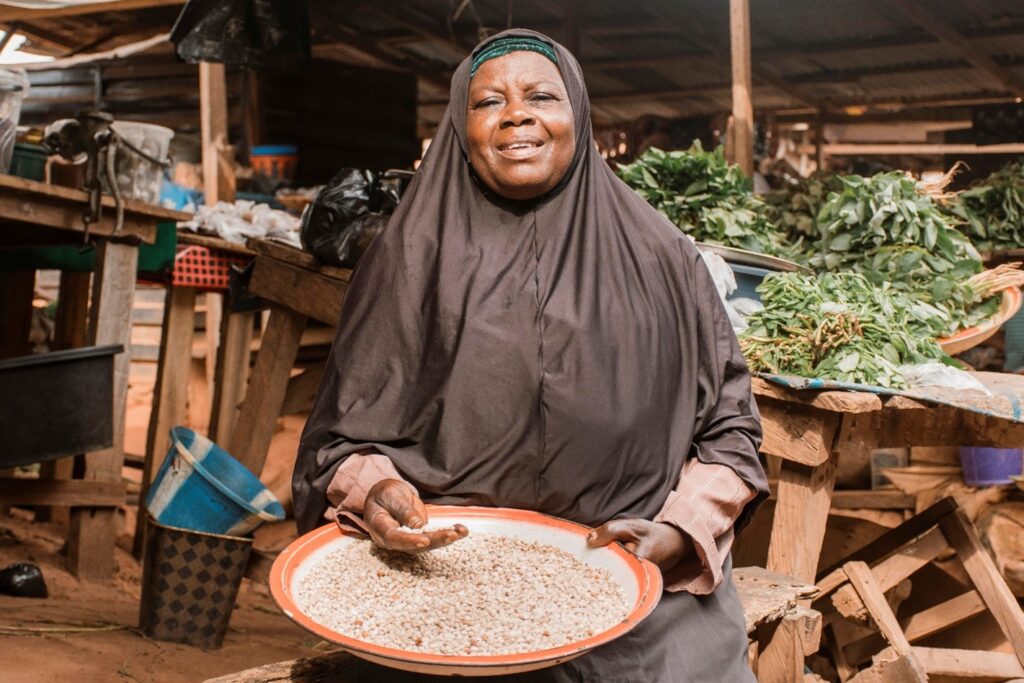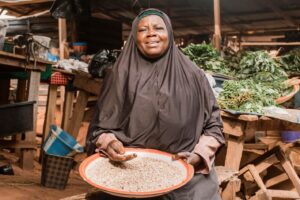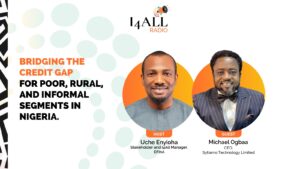I4ALL Radio
S1 E1: Transcript

An interview with Mr Michael Ogbaa, CEO, Sytiamo Technology Limited
Hello and welcome to Inclusion for All Radio, where we have pro-poor conversations for equity, access, and opportunity. Here, we unpack the barriers that keep millions of Nigerians from achieving full financial and economic inclusion.
Each episode spotlights the challenges that excluded populations face, and explores the innovations, policies, and partnerships that can break those barriers for good. I’m your host, Uche Enyioha, Stakeholder and Inclusion for All Manager at EFInA.
Today, we’re turning our focus to one of the most pressing challenges facing Nigeria’s poor, rural, and informal communities: access to credit. According to EFInA’s 2023 Access to Financial Services (A2F) Survey, only 10% of low-income adults in Nigeria have access to formal credit, while 77% have never borrowed from a formal financial institution. The gap is even wider in rural areas, with just 2.7% of adults having borrowed from a formal financial institution, compared to 8.3% in urban areas.
Yet, millions of Nigerians continue to save, lend, and repay loans within informal groups such as village savings and loan associations. This behaviour reveals a strong foundation, one that could be harnessed to build a more inclusive and trusted credit system.
In this episode, we’ll explore how to bridge that gap: what’s changing, what’s missing, and what bold moves can shift the needle toward true credit inclusion.
To help unpack this, I’m joined by Mr. Michael Ogbaa, CEO of Sytiamo Technology Limited, a company driving innovation in credit access for underserved populations.
Uche:
Michael, it’s great to have you on the show today.
Michael:
Thank you very much for having me. It’s my pleasure, and I’m looking forward to our discussion.
Uche:
Absolutely. Let’s start with a quick icebreaker. Can you recall the first time you ever accessed credit? What was it for, and how easy, or difficult, was it to get?
Michael:
It was very difficult. In fact, I didn’t have access to any form of credit until I started my banking career. Before then, any time you approached a financial institution, the first question was always, “Do you have collateral?” They wanted to know what you could provide in case their money wasn’t repaid. At that time, I had nothing to offer, so it was practically impossible to access credit. It wasn’t until much later, after I began working in banking, that I finally got my first loan.
Uche:
Interesting. And building on that, one question many people often ask is, why credit? Why is access to credit so central to achieving our financial goals? EFInA’s 2023 A2F Survey shows that only about 1% of Nigerian adults who set financial goals reported using formal credit to achieve them. The data also shows that many adults choose not to borrow because they don’t want to be indebted. So why should credit remain such an important part of the financial inclusion conversation?
Michael:
That’s a great question. As you rightly mentioned, I run a micro-lending institution, and one thing we’ve consistently noticed is that when you try to open an account for an average Nigerian adult, the first question they ask is, “What’s in it for me?” They often wonder, “Are you including me just to collect my data? Are you giving me an ATM card I don’t need? Or are you including me for your own benefit?”
We once conducted a small survey in Sytiamo, especially among market women and micro-borrowers we worked with, and what we found was shocking. Many of them did not want to have a bank account. When we asked why, they said, “Banks don’t help us. If we open an account, they’ll force an ATM card on us, charge ₦2,000 for it, and every year deduct maintenance fees for something we don’t use. And when we actually need money for our businesses, they won’t lend to us. So why should we open an account? We don’t want to be included.”
It was an eye-opening revelation for us. But it also made things easier, because as a micro-lender, we could offer what they truly needed: access to small business loans. So, opening an account or working with us became easy for them. That’s why lending, borrowing, and access to finance are such integral parts of true financial inclusion.
Uche:
Absolutely. And the data also shows that while many people, especially women in informal trade, may not borrow formally, a significant number, about 31%, borrow through informal sources instead. So, how is the formal credit space evolving to better integrate this segment into the formal lending ecosystem? Would you say the challenge lies in the product design, access channels, or perhaps trust, where consumer engagement and protection aren’t strong enough to inspire confidence?
Michael:
It’s really a combination of all those factors—and even more. Let me share a story. When we started Sytiamo, we studied what worked and found that one of the most impactful formal financial products at the time was Diamond Bank’s Beta Account (now part of Access Bank). It was revolutionary because Diamond Bank took banking directly to the markets, meeting women right where they were.
Whether they wanted to save ₦20,000, ₦2,000, or ₦1,000 a day, there was always a Diamond Bank agent visiting their shop to collect their savings. When they needed to withdraw or borrow, they didn’t have to go to the bank, the agents came to them. That level of accessibility built trust. More importantly, it offered convenience, which was what truly resonated with these women.
At Sytiamo, we adopted that same model. We meet customers where they are. Our field agents go into communities to serve them. When we lend, we no longer disburse in cash; we transfer the funds directly to their accounts, and our agents are on hand to confirm receipt. For those who prefer to withdraw, POS services make it easy, since POS terminals are now everywhere.
The truth is, many formal institutions still don’t fully understand the realities, behaviours, and needs of this segment. Informal borrowers are disciplined, they save, they borrow, and they repay. What’s missing is empathy and a localised understanding from the formal sector.
Uche:
That’s a strong point. Considering infrastructure gaps and the hard-to-reach nature of some communities, what practical steps can formal lending institutions take to bring their services closer to these populations?
Michael:
It’s a huge challenge, and one that can’t be solved by the private sector alone. The cost of reaching rural communities is significant. Take Bonny Island as an example, when the CBN mandated that POS agents shouldn’t charge more than ₦100 per transaction, operators there laughed, because transporting cash to Bonny Island involves crossing the sea, dealing with security risks, and other costs. People can’t pay less than ₦1,000 for cash transactions under those conditions.
So, meeting rural dwellers at the point of their need isn’t just about infrastructure, it’s also about cost. That’s why collaboration is key. The private sector, government, and communities must all work together.
We already have touchpoints in every community: hospitals, schools, and post offices. These existing structures can serve as access points for financial inclusion. Without partnerships and shared infrastructure, it will remain too expensive for the private sector to sustain alone.
Uche:
Very important point, the need for collaboration and cross-sector partnerships to truly extend inclusion. Let’s shift to another critical topic: KYC. If you think about a petty trader in Zaria or a vulcaniser in Aba, what are their real chances of accessing a formal loan when KYC requirements and documentation still pose a barrier?
Michael:
KYC shouldn’t be such a major obstacle anymore because the government has made significant progress in national identification. We have over 100 million Nigerians with a National Identification Number (NIN) and over 90 million registered voters. Combined with the Bank Verification Number (BVN), these systems provide solid touchpoints for verification.
If an individual has any of these: NIN, BVN, or a voter’s card, they can easily be identified. These databases already exist, managed by NIMC, NIBSS and INEC respectively. Unless a person has none of these, conducting KYC should be straightforward. And with ongoing voter registration and NIN enrolment, access is continuously improving.
Uche:
True, but with the current KYC framework, someone with just a NIN or BVN typically qualifies for only a Tier 2 account. Many MSMEs, especially in the North, that handle high transaction volumes but lack proof of address or business registration, struggle to upgrade to Tier 3. This limits their ability to transact and reduces their incentive to maintain formal accounts. What’s your perspective on this?
Michael:
When your business begins to scale, it’s your responsibility to start solving some of these challenges yourself. For instance, if Madam Adamu is the largest grain or groundnut trader in her local market, she can start forming partnerships with nearby businesses.
Let’s say there’s a petrol station nearby; she can collaborate with them to manage cash flow, either by accepting or disbursing cash on their behalf. She can also work with other market women who need cash for daily trade. These informal partnerships can function effectively even before full business registration or Tier 3 compliance.
At Sytiamo, we’re innovating around this idea, creating hubs that connect cash suppliers and cash users within communities. For example, if a distributor needs proof of payment to companies like Coca-Cola or Pepsi on a weekend when banks are closed, our field agents can facilitate the transaction and issue confirmation transfers instantly.
There’s already a lot of creativity happening at the bottom of the pyramid. The key is understanding those systems and building around them, rather than waiting for everything to go through traditional banks.
Uche:
That’s fascinating. There’s definitely room for innovation and increased financial literacy at that level. My final question, before we wrap up: if you had to recommend one bold policy move or innovation that could radically expand credit access for underserved populations, what would it be?
Michael:
I’ll share a story. Years ago, when I was Head of E-Business at Access Bank, the Central Bank introduced two programmes: TraderMoni and MarketMoni, under the federal government’s financial inclusion initiatives. Many people remember MarketMoni because the former Vice President, Professor Osinbajo, often distributed ₦10,000 loans to traders in markets. But there was another programme, TraderMoni, which offered much higher amounts, ranging from ₦150,000 to ₦400,000.
Interestingly, while many MarketMoni beneficiaries didn’t repay, TraderMoni achieved over 90% repayment. Why? Because the CBN implemented strict enforcement. Defaulters’ BVNs were blacklisted, they were literally cut off from the financial system. When they tried to access their bank accounts, they couldn’t. That policy worked.
So, if I could push for one bold move, it would be to reintroduce similar accountability mechanisms. Nigerians tend to respond to both the carrot and the stick. If defaulting on a loan means you can’t renew your driver’s license, obtain a passport, or vote, people will think twice before defaulting.
We need to make repayment discipline part of the system. We already have the BVN linking everyone, let’s use it effectively. If you borrow, you must repay. Otherwise, you should face clear consequences. That’s the kind of policy shift I’d like to see happen in my lifetime.
Uche:
Very interesting, and it highlights the importance of improving credit literacy so that people can borrow responsibly and sustainably.
Thank you so much, Michael, for sharing these insights. It’s clear that bridging Nigeria’s credit gap isn’t just about lending money; it’s about designing systems that reflect the realities and behaviours of the people we want to serve.
At EFInA and Inclusion for All, we’ll continue working to ensure the financial system works for everyone, everywhere.
To listen to this episode on Inclusion for all Radio Click here






